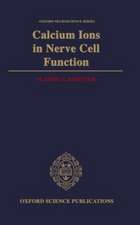The Neurobiology of Computation: Proceedings of the Third Annual Computation and Neural Systems Conference
Editat de James M. Boweren Limba Engleză Paperback – 12 noi 2012
| Toate formatele și edițiile | Preț | Express |
|---|---|---|
| Paperback (1) | 1279.86 lei 43-57 zile | |
| Springer Us – 12 noi 2012 | 1279.86 lei 43-57 zile | |
| Hardback (1) | 1286.29 lei 43-57 zile | |
| Springer Us – 31 iul 1995 | 1286.29 lei 43-57 zile |
Preț: 1279.86 lei
Preț vechi: 1599.82 lei
-20% Nou
Puncte Express: 1920
Preț estimativ în valută:
244.90€ • 256.34$ • 203.84£
244.90€ • 256.34$ • 203.84£
Carte tipărită la comandă
Livrare economică 31 martie-14 aprilie
Preluare comenzi: 021 569.72.76
Specificații
ISBN-13: 9781461359401
ISBN-10: 1461359406
Pagini: 464
Ilustrații: XV, 444 p.
Dimensiuni: 155 x 235 x 24 mm
Greutate: 0.64 kg
Ediția:Softcover reprint of the original 1st ed. 1995
Editura: Springer Us
Colecția Springer
Locul publicării:New York, NY, United States
ISBN-10: 1461359406
Pagini: 464
Ilustrații: XV, 444 p.
Dimensiuni: 155 x 235 x 24 mm
Greutate: 0.64 kg
Ediția:Softcover reprint of the original 1st ed. 1995
Editura: Springer Us
Colecția Springer
Locul publicării:New York, NY, United States
Public țintă
ResearchCuprins
Section 1: Subcellular.- 1 A Mathematical Description of Quantal Analysis with Applications.- 2 Fast Kinetic Models for Simulating AMPA, NMDA, GABAAand GABAB Receptors.- 3 An Equilibrium Model of Biochemical Interactions Between Glutamatergic and Dopaminergic Signals in Striatal Neurons.- 4 Simulation of the Molecular Mechanisms Regulating Neurotransmitter Release.- 5 The Potassium A-Current Low Firing Rates in Hodgkin-Huxley Models.- 6 Apparent Diffusion Coefficient Estimation Errors from Using Ratio of Bound to Unbound Ca2+.- Section 2: Cellular.- 7 Information Maintenance by Retinal Ganglion Cell Spikes.- 8 Modeling the Bursting Interneurons of the Lobster Cardiac Ganglion.- 9 Precision and Reliability of Neocortical Spike Trains in the Behaving Monkey.- 10 Summation and Division in V1 Simple Cells.- 11 Qualitative Electrotonic Comparison of Three Classes of Hippocampal Neurons in the Rat.- 12 A New Spike Train Analysis Technique for Detecting Trends in the Firing Patterns of Neurons.- 13 A Mathematical Model of Retinal Photoreceptors.- 14 Short-Term Memory as a Single Cell Phenomenon.- 15 The Importance of Membrane Properties and Synaptic Location in Octopus Cells of the Mammalian Cochlear Nucleus: A Modeling Study.- 16 Hypertext Software For Modeling Neurons.- 17 The STEM Cell: A Computational Model of Biological Neurons Useful for Spatio-Temporal Pattern Recognition.- 18 Functional Interactions Between Inwardly Rectifying Conductances and GABAA-mediated Inhibition.- 19 A Compartmental Model of the Cochlear Nucleus Stellate Cell: Responses to Constant And Amplitude-Modulated Tones.- 20 Is A Classification of Honeybee Antennal Lobe Neurones Grown in Culture Possible? - Yes!.- 21 How Does Retinal Preprocessing Affect the Receptive Field of A Stabilized Hebbian Neuron.- 22 Electrotonic Structure and Synaptic Variability in Cortical Neurons.- 23 Synaptic Coding of Time-Varing Spike Trains.- 24 Calculation of Passive Membrane Properties for Experimentally Determined Dendritic Geometries of Laterodorsal Tegmental Neurons in Vitro.- 25 Dendritic Electrotonic Extent and Branching Pattern Topology.- Section 3: Network.- 26 Localised Neuronal Assemblies with Recurrent Synapses Enable Global Temporal Synchronisation.- 27 Attention As Selective Synchronization of Oscillating Cortical Sensory and Motor Associative Memories.- 28 Perceptual Topography: Spatio-Temporal Analysis of Prepyriform, Visual, Auditory, and Somesthetic EEGs in Perception by Trained Rabbits.- 29 BIONNIC: An Efficient and Flexible Integrator for Biological Neural Network Simulators.- 30 A Retina Model Including Dopaminergic Neuromodulation.- 31 Parameter Optimization of Olfactory Neurodynamics.- 32 Model Synapses with Frequency Potentiation Characteristics Can Cooperatively Enhance Hebbian Learning.- 33 Low Spiking Rates in a Network With Overlapping Assemblies.- 34 The Role of Feedback in Respiratory Amplitude and Frequency Modulation.- 35 Partial and Full Synchrony of Thalamic Spindle Oscillations.- 36 On The Stochastic Stability of a Neural Network Model of Somatosensory Information Processing.- 37 Feedback Regulation of Cholinergic Modulation and Hippocampal Memory Function.- 38 Analyzing the Hippocampal Place Cell Phenomenon by Modeling the Central Visual Pathway.- 39 Effects of Asymmetric Neuronal Connectivity and Dopamine on Striatal Function: Simulation and Analysis of a Model for Huntington’s Disease.- 40 Learning and Classification in a Noisy Environment by A Simulated Cortical Network.- 41 Improving the Realism of Attractor Models by Using Cortical Columns asFunctional Units.- 42 Oscillations, Chaos and Noise in Associative Memory.- 43 Ordor Processing in the Honey Bee’s Antennal Lobe Glomeruli: Modeling Sensory Memory.- 44 The Interplay of Intrinsic and Synaptic Currents in a Half-Center Oscillator.- 45 A Model of the Spatial-Frequency Organization in Primate Striate Cortex.- 46 A 3-D Interactive Model for Peripheral Vestibular Signal Processing.- 47 Models of Adaptive Electrosensory Self-Noise Cancellation in a Cerebellar-Like Structure in the Elasmobranch Hindbrain.- 48 Multistable Phase-Clustering in Networks of Spiking Neurons.- 49 Decoding Vectorial Information from Firing Rates.- 50 Modeling Cortical Plasticity Based on Adapting Lateral Interaction.- 51 An Emergent Model of Visual Cortical Orientation Selectivity.- 52 Computational and Neurobiological Features of a Network of Networks.- 53 Using Fictive Powers as Event Markers in EEG Data Processing.- 54 Visual Segmentation and Feature Binding Without Synchronization.- 55 Oscillatory Field Potentials in the Presence of Irregular Single Cell Discharge Patterns.- 56 Stimulus-Dependent Synchronization in a Model of Orientation-Tuned Spiking Neurons.- 57 XNBC: A Simulation Tool for Neurobiologists.- 58 Simulations of the Intersegmental Coordination During Swimming in the Lamprey Using A Continuous Network Model.- 59 Linear and Nonlinear Dynamics in the Development of Orientation Preference Maps.- Section 4: Systems.- 60 Neural System of Fear Conditioning: A connectionist Model.- 61 The Generation of Expectations In Cerebellum-Like Structures.- 62 A Neural Controller for Single-Leg Substrate-Finding: A First Step Toward Agile Locomotion in Insects and Robots.- 63 VLSI Neuromorphs: Building Blocks for Neural Circuits.- 64 Test of a Two-Layer Network as a Model of HumanEntry-Level Object Recognition.- 65 Understanding Ocular Dominance Development from Binocular Input Statistics.- 66 Timing a Looming Object.- 67 Depth from Transparency.- 68 Cortical Competitive Processing Produces Interference In Color-Word Tests.- 69 A Computational Model of Attentional Focus: The Searchlight of Attention Hypothesis Revisited.- 70 Neural Implementation of Bayesian Vision Theories by Unsupervised Learning.- 71 Comparison of Gender Recognition by PDP asnd Radial Basis Function Networks.












